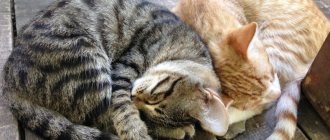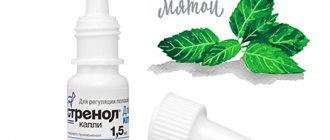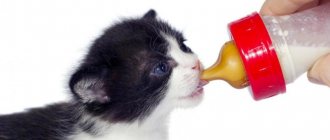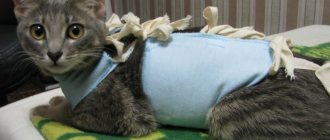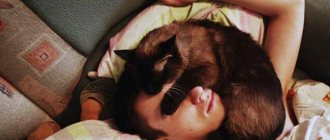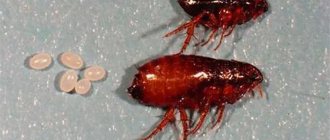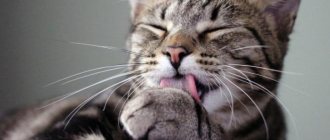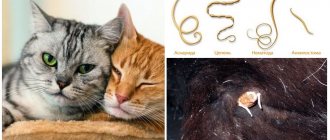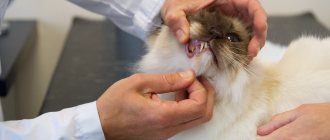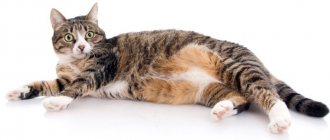What will you learn from the article?
- When kittens start teething Signs of teething in kittens
- How to help a kitten during teething
- Dental formula of kittens and cats
- How long does it take for kittens to change their teeth?
- Symptoms of diseases
- Causes of tooth loss
A cat's teeth are not only a tool for capturing and chewing food, but also a weapon of a predator. Animals use their teeth to hunt and defend themselves. A cat's teeth serve as an indicator of its health and help determine its age. Nature has provided predatory cats with everything they need, but the owner will have to take care of the health of the pet’s oral cavity and teeth.
How many teeth do cats and kittens have? When does teeth change? What is the structure and arrangement of cat teeth? What dental pathologies occur in cats? How to keep your pet's teeth healthy? You will find answers to all these questions in our material.
How the jaw is formed, photo diagram
Kittens are born toothless, just like human children. However, the formation of their bite occurs much faster than in humans: after only 2 or 4 weeks, the first milk teeth begin to erupt, and after another few months the process ends with the formation of molars.
The order of teething in kittens is similar to the same process in human children. First, the incisors appear, then the canines and premolars. The last to erupt are the molars. A kitten that is three months old should have 26 teeth - 14 on top and 12 on the bottom.
But the process of bite formation does not end there. As soon as the baby teeth grow completely, they begin to be replaced by molars in the same sequence.
Usually, by the age of 8-10 months, the formation of the jaw in an adult animal is completely completed. Until then, it is preferable to feed the cat food high in phosphorus, calcium and other minerals. Thanks to this, the teeth will be strong and the kitten will be healthy.
Dental system: the role of each element
As mentioned above, an adult cat has 30 teeth. The structure of the system itself in the oral cavity is predetermined by the purpose of each individual element. The following can be said about each type of teeth:
- Incisors are small teeth located in front on both jaws, 6 pieces each. The cat, as a rule, does not use them to chew food: it only needs them to hold prey and large pieces.
- Fangs are elongated teeth that cats use in the process of killing prey. They are quite strong because they are held deeper than other teeth by ligaments. The cat's jaws have one fang on both sides.
- Premolars are bone formations in the oral cavity that perform chewing functions. Cats need 6 upper and 4 lower premolars to grind food, especially meat. If it is necessary to remove a superficial crown, it is important to remove the root of such a tooth.
- Molars are the most difficult to reach massive teeth. They help animals break down solid food.
In kittens
The number of teeth kittens have depends on their age. Due to their property of not growing at the same time, it is possible to quite accurately (within one month) determine the age of an animal simply by looking at which teeth have already grown and which have not yet grown. True, this method of determining age loses its relevance for adult animals.
Determining age by teeth
Did you adopt a stray animal from a shelter or pick it up on the street? Great action! Very soon the foundling will recover from the stress it has suffered, will fatten up and turn into a large beautiful cat or a charming fluffy kitty. You dote on your new pet and have only one regret: that you don’t know how old he is.
Meanwhile, determining the age of a cat is not so difficult; just look at its teeth.
- Newborn babies have no teeth. The first ones, the primary incisors, appear in the period from the second to the fifth week of a kitten’s life.
- Primary canines begin to grow from the third to the eighth week.
- Two or three weeks after the appearance of the primary canines, the primary premolars erupt.
- From three to six months, kittens' milk teeth are replaced with permanent ones.
- A young animal has thirty teeth per year: sixteen upper and fourteen lower. If they have a snow-white tint without any hint of yellowness, are sharp and not worn off, you can say with complete confidence that you have a one-year-old pet.
- By the age of one and a half years, a cat's teeth begin to turn slightly yellow.
- At the age of two years, signs of wear appear on the middle incisors of the lower jaw, and a yellow tint becomes clearly visible. At the same age, cats begin to form tartar.
- By the age of three, signs of wear on the central lower incisors become clearly visible.
- At the age of five, cats' fangs begin to wear off. All teeth are covered with a clearly visible dark yellow coating.
- By the age of six, the chewing surface of the incisors begins to gradually deteriorate.
- The upper and lower incisors of cats wear down by the age of seven or eight years.
- At the age of ten years, many animals lose their central lower incisors, and some lose their upper ones.
- When there are no incisors left in a cat’s mouth at all, there is no doubt that she is between twelve and fourteen years old.
- By the age of fourteen or fifteen, cats lose their fangs. In general, the number of teeth in animals of this age greatly depends on what and how they eat, as well as on whether the owner takes care of the pet’s teeth. In the complete absence of any care, difficult living conditions, and poor nutrition of the animal, only an experienced specialist can determine its approximate age, since all this in one way or another affects the condition of the teeth.
Features of wound treatment
In case of serious wounds to the tail, accompanied by severe and profuse bleeding, we would advise not to engage in “amateur activities”, but to immediately show the cat to a veterinarian.
A specialist will be able to immediately determine the severity of the injury. Secondly, it is necessary to immediately cut the affected area of the body so that the wound is clearly visible and can be properly cared for.
We strongly recommend using scissors with rounded ends for this purpose. This will prevent additional injury to the skin. After freeing the edges of the wound and some of the skin nearby, clean off blood and other debris using a cotton pad soaked in sterile saline solution. After this, you can lubricate the edges (but not the wound itself!) of the wound canal with alcohol tincture of iodine.
Take a good look inside. If bones or bone fragments are clearly visible in the thickness of the wound, further independent treatment is not advisable: we advise you to contact a veterinarian as soon as possible.
In cases where the injury is not so serious, you can try to cope with the problem yourself. Light abrasions and wounds can simply be covered with a bandage, but not everything is so simple: most likely, your cat’s tail was not injured in the operating room, and therefore the wound canal is inevitably contaminated with microflora. Simply put, the tail will quickly become inflamed.
To avoid this, it is necessary to use Vishnevsky’s balsamic liniment, or synthomycin liniment. Ichthyol ointment has also proven itself well. These are very simple, cheap, but still extremely effective remedies.
They are also easy to use. First, soak a gauze pad with the ointment, and then apply it over the wound (previously cleaned of hair and other contaminants). To prevent the napkin from rolling off, it is fixed by making a tight bandage.
And this is where problems can arise: if you simply put a bandage on the tail, the bandage will soon fly out of its place, and therefore there will be no use from it. To prevent this from happening, you need to start bandaging from the tip of the tail (more precisely, closer to it), lifting the bandage upward in a spiral, towards the root of the tail.
Another problem is cats' tendency to rip off any bandages. If the cat constantly frees its tail from the bandage, it will take a very long time to treat it, and without any special guarantees of success. When your pet is particularly active and impatient, we highly recommend that you immediately consult a veterinarian and place a surgical collar on the animal's neck.
If for some reason this is not possible, you can lubricate the outside of the bandages with something bitter and very unpleasant to the taste. For example, pure ichthyol (which, among other things, has a pronounced anti-inflammatory effect) is suitable.
When to resort to radical methods of treatment?
If your cat cannot feel its tail (that is, does not react in any way to its pin pricks) and has urinary and fecal incontinence, there is no point in engaging in “self-medication”.
In addition, this happens in advanced cases of tail injuries, when the infection in the blood vessels of the organ begins to spread higher. In such situations, it is recommended to urgently remove the affected body part surgically. Of course, a tailless cat will lose some of its agility and grace, but will remain alive.
Serious injuries to a cat's tail can cause the cat to experience (sometimes lifelong) problems with urination and defecation. It is necessary to prescribe diuretics and stool softeners (as well as laxatives). When things get really bad, it comes down to indwelling urinary catheters.
Brushing and caring for your teeth
In order for your pet to remain in excellent physical shape until old age, you must not only feed him fresh, good-quality foods and regularly carry out hygiene procedures, but also pay special attention to the condition of his teeth. After all, healthy, strong teeth are the key to an animal’s health. They help to capture and chew large pieces of prey well (even if it is taken out of the jar and placed in a bowl by a caring owner), which, in turn, promotes normal digestion.
Regular teeth cleaning, carried out according to all the rules, prevents the formation of tartar, which consists of salts, food and bacteria, strongly hardened and deposited in the area of the roots of the teeth. The vital activity of bacteria causes inflammation of the gums, their detachment, as a result of which the necks of the incisors and canines are exposed. It becomes painful for the animal to chew, and his breath smells bad. Discomfortable phenomena are accompanied by loss of appetite, and as a result, loss of body weight. Very often, teeth affected by stones fall out prematurely.
Nothing like this will happen if the cat’s diet contains solid food that helps mechanically clean the teeth. In addition, your cat's teeth need to be brushed regularly.
The sooner you start getting your pet used to brushing its teeth, the better. Then, having become accustomed to such a procedure, the animal, upon becoming an adult, will not resist. However, experienced cat owners often manage to accustom cats that come to them at a fairly mature age to do this. By the way, cats calmly accept many not very pleasant procedures, intuitively feeling that the owner cares about their health.
You can clean your cat's teeth using:
- a clean finger wrapped in a bandage or gauze;
- a soft toothbrush intended for children;
- a special brush attachment that is used to clean the teeth of small animals.
Our toothpaste is not suitable for cats. Purchase a special cleaning paste for your pet at a pet store. Such pastes are completely harmless, easy to use, do an excellent job of cleaning teeth, cats like the taste and smell, and most importantly, do not require rinsing.
Don't rush to start cleaning right away. Let your pet get used to the taste of the paste - just place it on the animal’s cheek. After a day or two, apply a very small amount of paste to the brush and try brushing the animal’s teeth with it. Don’t be upset or despair if even your pet breaks out of your hands and scurries under the sofa. Remember how you hated brushing your teeth as a child, but over time you got used to it! Don't back down. Soon the cat will understand that brushing his teeth is included in the list of daily procedures along with eating or going to the toilet, and he will come to terms with the inevitable.
The first brushings may only last a few seconds, but as your pet adapts a little, increase these hygiene procedures to two or three minutes. Just don't go too hard. Your goal is only to remove plaque from your teeth.
The most convenient way to brush a cat's teeth is to turn his back to you, using the same movements as if you were brushing your teeth.
Causes of diseases
All cat teeth are small in size and very sharp. They can suffer physically from various incidents, for example, it is not uncommon for a cat to have a broken tooth due to eating the wrong food or due to injury. The main causes of damage to teeth are impacts; they are knocked out during falls and accidents with vehicles.
Sometimes the cause of breakage and serious damage is bones that accidentally end up in cat food, or this happens when a cat eats a caught mouse or bird.
Usually, after such incidents with the cat’s teeth, roots are left that are easily inflamed and painful. When asked what to do in such a situation, it can be recommended to contact a veterinarian and remove the remains, since they will most likely bother the animal and will soon cause inflammation of the gums.
In addition to mechanical damage, the following conditions or diseases can cause problems:
- Genetic predisposition. Most often, structural defects and a tendency to disease are found in cases where the cat belongs to a breed obtained as a result of human selection efforts.
- Pathologies of location. Some breeds are missing one or two teeth, which negatively affects the functioning of the entire apparatus.
- Improper or insufficient nutrition. This has a particularly negative effect on the condition of the bones and teeth of kittens if their mother was malnourished or starved during pregnancy, or if they received poor nutrition in the first months of life. In the future, disruption of the structure and functions of the oral apparatus can be provoked by monotonous, poor food with insufficient amounts of vitamins and minerals.
- Bad ecology. A cat, like a person, will suffer from poor quality water, polluted air and artificial chemical food.
- Infections. They cause inflammation of the gums and tooth tissues, causing it to become loose in the socket, and a swaying tooth can easily break or simply fall out. Sometimes tooth resorption occurs due to infection in domestic cats.
- Insufficient oral hygiene. Plaque that is not removed in time turns into hard tartar, which injures the gums, causes inflammation and causes putrefactive processes and tooth loss, as well as many diseases of internal organs.
INTERESTING TO FIND OUT: Why does a cat lose teeth?
Since there are many reasons for a cat's oral cavity, owners will need to monitor it closely to catch problems early.
When do kittens' baby teeth change?
Kittens' teeth begin to change between three and four months of age. Sometimes this process can be delayed even up to five months of age. In any case, it will begin sooner or later, but the sooner it ends, the better. This is due to the peculiarities of the formation of the animal’s jaw. When baby teeth are replaced late by molars, the bite may develop incorrectly.
During the period of changing teeth, the kitten becomes restless, begins to meow and in every possible way demonstrate to the owner that he is experiencing discomfort. At the same time, he begins to chew absolutely everything that is within reach: wires, books, children's toys, pencils, the backs of chairs and even the hands of the owners.
When a kitten shows signs of replacing baby teeth with molars, it needs to be provided with proper nutrition. Try to give your pet maximum attention during this time, never deny yourself the pleasure of cuddling and stroking him. This will help your child get through a difficult period easier.
If not all of your pet's baby teeth have fallen out, and the growth of the molars is already coming to an end, it is best to contact your veterinarian to have them removed.
Dental services
Typically, veterinary clinics provide cats with dental services such as tartar cleaning and removal of baby and molar teeth.
Brushing a cat's teeth is a procedure that can be done at home by the owner. However, in some advanced cases, plaque on the teeth cannot be removed with a special toothbrush and cat paste and you have to go to the veterinarian. There are two methods for its removal - mechanical and ultrasonic.
In the first case, the animal is subjected to general anesthesia, after which the deposits are scraped off using special instruments. Unfortunately, this can damage tooth enamel, which will inevitably lead to tooth decay in the future. In addition, an inexperienced doctor can damage your pet's gums, after which long-term treatment will be necessary.
The second method of removing plaque involves treating the animal’s oral cavity with ultrasound emitted by a special apparatus. This is a completely painless procedure that often does not require general anesthesia. Unfortunately, it is quite expensive and requires equipment that may simply not be available at your local veterinary clinic.
The kitten's baby teeth are also removed under general anesthesia. In the hands of professionals, this procedure is completely painless and helps prevent the animal from developing an incorrect bite and such a serious disease as periodontal disease.
Molars should be removed only as a last resort: if they are seriously damaged or the animal has developed a serious oral disease - for example, a dental abscess. This is also done under general anesthesia, but, unfortunately, the operation is often poorly tolerated by animals, so it is resorted to only as a last resort if there is a risk to the life and health of your pet.
Regular brushing will help keep your pet's teeth strong and healthy into old age. Don't neglect this. Then your pet's life will be long, happy and comfortable.
When does an adult cat start to lose teeth?
A healthy animal should have all its teeth in place. If you find that your pet is missing one or more teeth, there can only be one explanation for this: improper care. Most likely, you simply did not monitor the condition of the cat’s oral cavity and the teeth began to decay. Or she suffered an injury that could result in her losing several teeth.
However, in older cats, tooth loss is a natural and, unfortunately, inevitable process. This has nothing to do with poor nutrition or injury, they are simply no longer able to stay in their place. Between the ages of 10 and 12 years, the central incisors fall out. Over the next four years, other teeth, except for the canines, may fall out. Those fall out the very last - at the age of over 16 years.
Reasons for loss
Examining your pet's oral cavity will help you find out not only whether all the teeth are in place, but also in what condition they are. To do this, the pet is placed on a well-lit, stable table. A quick inspection only takes a minute or two. Most pets are comfortable with this procedure.
But before you open your cat's mouth, inspect its face for swelling. Often a broken upper fourth premolar will cause an abscess that can spread to the area under the eye. Fractures of the upper canines (or eye teeth) can also cause swelling of the upper part of the nose. Next, feel your neck below your ears. Abnormal swelling of this area may occur due to infection, cancer, or inflammation.
The main causes of tooth loss are:
- The natural aging process of a pet. Compared to humans, cats have better dental apparatus: a thicker protective layer of enamel and less destructive saliva. Cat food contains no sugar, and food particles are less likely to get stuck between teeth. And yet, as they age, they lose teeth. Cats usually adapt quickly to tooth loss and can cope with food even if some or all of their incisors are missing. Some cats can still eat dry food even if all their teeth have fallen out.
- Changing teeth in kittens. As a rule, the absence of a tooth does not cause any inconvenience to the baby.
- Oral diseases. Lack of regular cleaning can lead to loose teeth and periodontal disease. Due to the accumulation of bacterial byproducts on the gums, the bone that holds the teeth in their sockets is destroyed. The teeth begin to loosen. Not only does this make it inconvenient for your cat to eat, but she may end up with loose teeth. The incisors are usually affected before the back teeth.
In addition, a cat can lose teeth by grabbing something hard or in a fight with other animals (cats, dogs). Also, the cause of tooth loss can be injury (fall from a height, blow to the jaw).
Stomatitis
There is growing evidence that various organs of the body can be affected by bacteria and toxins that enter the body through the bloodstream from the mouth. Chronic inflammation in a pet's mouth can cause problems such as elevated liver enzymes, heart disease, kidney disease and diabetes.
Is it scary that a cat has no teeth?
A cat's lack of teeth is a negative phenomenon that can make serious adjustments to his life. He can no longer hunt and defend himself from the attacks of his younger and stronger relatives, and can only eat soft food.
It is advisable to keep an elderly cat that has lost teeth at home, and, if possible, not let it go outside. You never know who he will decide to fight with, or, on the contrary, who will attack him. The consequences in both cases can be disastrous.
You'll have to reconsider your pet's diet. The cat is a carnivore, which means it needs meat. But he can no longer chew its fibers on his own. The solution can be found by giving it to the cat in a rolled and ground form.
